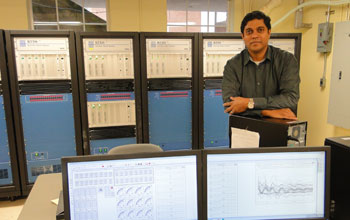 In a recent article posted to the Discoveries section of the National Science Foundation’s web site, writer Valerie Thompson, explores how scientists are trying to tap into the “unmatched ability of the human brain to process and make sense of large amounts of complex data” and utilize that in the development of ‘smart’ power grid systems currently being developed.
In a recent article posted to the Discoveries section of the National Science Foundation’s web site, writer Valerie Thompson, explores how scientists are trying to tap into the “unmatched ability of the human brain to process and make sense of large amounts of complex data” and utilize that in the development of ‘smart’ power grid systems currently being developed.
The research in this area is reportedly being led by Ganesh Kumar Venayagamoorthy, Ph.D., director of the Real-Time Power and Intelligent Systems Laboratory at Clemson University. His team of neuroscientists and engineers is using actual brain neurons, grown in a dish, to control simulated power grids. The team aims to find new methods for managing the country’s power supply by observing how neural networks integrate and respond to complex information.
“The brain is one of the most robust computational platforms that exists,” says Venayagamoorthy. “As power-systems control becomes more and more complex, it makes sense to look to the brain as a model for how to deal with all of the complexity and the uncertainty that exists.”
A little over a century ago, isolated power plants served power only to local customers. Today, an estimated 200,000 miles of power lines inter-connect more than 6000 powerplants in a power grid structure to ensure a backup of power across the country in the event that some plants fail. This makes efficiently managing all of that power a complex and delicate task.
The current grid system is severely outdated and struggles to keep up with the higher demands for electric power in today’s high-tech environment. Most powerplants were originally built 50 years ago when demands and consumption were significantly different. The technology and components in place at many power stations are outdated or have exceeded their life expectancy.
Additionally, in order to effectively incorporate renewable sources of ‘green energy’ including solar and wind into the grid system requires a currently unavailable ability to store energy for later release into the system.
“In order to get the most out of the different types of renewable energy sources, we need an intelligent grid that can perform real-time dispatch and manage optimally available energy storage systems,” says Venayagamoorthy. The Department of Energy currently estimates that a mere 5 percent increase in the efficiency of the power grid would save the energy equivalent to taking 53 million cars off the road.
Venayagamoorthy believes that by modeling the grid based on neural interactions in the human brain we can achieve vast improvements in the efficiency of the energy grid. “What we need is a system that can monitor, forecast, plan, learn, make decisions,” says Venayagamoorthy. “Ultimately, what we need is a control system that is very brain-like.”
To understand just how the brain brain integrates and responds to information, Venayagamoorthy and turned to neuroscientist Steve Potter, Ph.D., director of the Laboratory for NeuroEngineering at the Georgia Institute of Technology. Potter’s research involves growing neurons in a dish containing a grid of electrodes that can both stimulate and record activity. The electrodes connect the neuronal network to a computer, allowing two-way communication between the living and the electronic components.
“The goal is to translate the physical and functional changes that occur as living neuronal network learns into mathematical equations, ultimately leading to a more brain-like intelligent control system,” says Venayagamoorthy.
So far the researchers have successfully “taught” a living neuronal network how to respond to complex data, and have incorporated these findings into simulated versions called bio-inspired artificial neural networks (BIANNS). They are currently using the new and improved BIANNS to control synchronous generators connected to a power system, with the hope that this work will pave the way for smarter control of our future power grid.
Valerie Thompson’s complete article can be read online at: http://www.nsf.gov/discoveries/disc_summ.jsp?cntn_id=127605&WT.mc_id=USNSF_1
![Herbal Reference Substances are Key to Everyday Products <!-- AddThis Sharing Buttons above -->
<div class="addthis_toolbox addthis_default_style " addthis:url='http://newstaar.com/herbal-reference-substances-are-key-to-everyday-products/3512112/' >
<a class="addthis_button_facebook_like" fb:like:layout="button_count"></a>
<a class="addthis_button_tweet"></a>
<a class="addthis_button_pinterest_pinit"></a>
<a class="addthis_counter addthis_pill_style"></a>
</div>When it comes to quality control testing and the development of new products, Botanical Reference Materials (BRMs), also known as Herbal References are critically important. To help companies ultimately obtain all-important FDA approval, the Food and Drug Administration provides in its guidance a recommendation that […]<!-- AddThis Sharing Buttons below -->
<div class="addthis_toolbox addthis_default_style addthis_32x32_style" addthis:url='http://newstaar.com/herbal-reference-substances-are-key-to-everyday-products/3512112/' >
<a class="addthis_button_preferred_1"></a>
<a class="addthis_button_preferred_2"></a>
<a class="addthis_button_preferred_3"></a>
<a class="addthis_button_preferred_4"></a>
<a class="addthis_button_compact"></a>
<a class="addthis_counter addthis_bubble_style"></a>
</div>](http://newstaar.com/wp-content/uploads/2021/02/Achillea_millefolium_flowers-100x100.jpg)
![Quality Electrochemical Biosensors are Critical for Medical, Food and Chemical Industry <!-- AddThis Sharing Buttons above -->
<div class="addthis_toolbox addthis_default_style " addthis:url='http://newstaar.com/quality-electrochemical-biosensors-are-critical-for-medical-food-and-chemical-industry/3512086/' >
<a class="addthis_button_facebook_like" fb:like:layout="button_count"></a>
<a class="addthis_button_tweet"></a>
<a class="addthis_button_pinterest_pinit"></a>
<a class="addthis_counter addthis_pill_style"></a>
</div>A number of industries have, at their core, a need to frequent or even continuous analysis of biological media. These include the medical and pharmaceutical fields, biotech firms, and food and chemical companies. To maintain quality standards and develop new products, these industries rely heavily […]<!-- AddThis Sharing Buttons below -->
<div class="addthis_toolbox addthis_default_style addthis_32x32_style" addthis:url='http://newstaar.com/quality-electrochemical-biosensors-are-critical-for-medical-food-and-chemical-industry/3512086/' >
<a class="addthis_button_preferred_1"></a>
<a class="addthis_button_preferred_2"></a>
<a class="addthis_button_preferred_3"></a>
<a class="addthis_button_preferred_4"></a>
<a class="addthis_button_compact"></a>
<a class="addthis_counter addthis_bubble_style"></a>
</div>](http://newstaar.com/wp-content/uploads/2020/10/Electrochemical-Biosensor-100x100.jpg)
![Company Develops Industrial Mixers Well-Suited for both Fragile and Explosive Products <!-- AddThis Sharing Buttons above -->
<div class="addthis_toolbox addthis_default_style " addthis:url='http://newstaar.com/company-develops-industrial-mixers-well-suited-for-both-fragile-and-explosive-products/3512071/' >
<a class="addthis_button_facebook_like" fb:like:layout="button_count"></a>
<a class="addthis_button_tweet"></a>
<a class="addthis_button_pinterest_pinit"></a>
<a class="addthis_counter addthis_pill_style"></a>
</div>Industrial drum mixers are normally applied to blend mixes of varying viscosities such as adhesive slurries or cement. Some of these mixers have the capability of blending mixes of very different particle sizes such as fruit and ice cream, and gravel and cement slurry. The […]<!-- AddThis Sharing Buttons below -->
<div class="addthis_toolbox addthis_default_style addthis_32x32_style" addthis:url='http://newstaar.com/company-develops-industrial-mixers-well-suited-for-both-fragile-and-explosive-products/3512071/' >
<a class="addthis_button_preferred_1"></a>
<a class="addthis_button_preferred_2"></a>
<a class="addthis_button_preferred_3"></a>
<a class="addthis_button_preferred_4"></a>
<a class="addthis_button_compact"></a>
<a class="addthis_counter addthis_bubble_style"></a>
</div>](http://newstaar.com/wp-content/uploads/2020/06/bandeau-sofragir2-100x100.jpg)